非限定性定语从句教案
- 格式:doc
- 大小:35.00 KB
- 文档页数:2
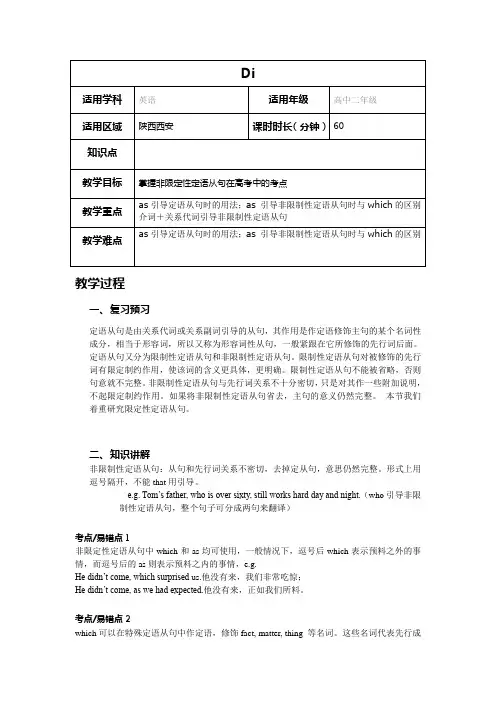
教学过程一、复习预习定语从句是由关系代词或关系副词引导的从句,其作用是作定语修饰主句的某个名词性成分,相当于形容词,所以又称为形容词性从句,一般紧跟在它所修饰的先行词后面。
定语从句又分为限制性定语从句和非限制性定语从句。
限制性定语从句对被修饰的先行词有限定制约作用,使该词的含义更具体,更明确。
限制性定语从句不能被省略,否则句意就不完整。
非限制性定语从句与先行词关系不十分密切,只是对其作一些附加说明,不起限定制约作用。
如果将非限制性定语从句省去,主句的意义仍然完整。
本节我们着重研究限定性定语从句。
二、知识讲解非限制性定语从句:从句和先行词关系不密切,去掉定从句,意思仍然完整。
形式上用逗号隔开,不能that用引导。
e.g. Tom’s father, who is over sixty, still works hard day and night.(who引导非限制性定语从句,整个句子可分成两句来翻译)考点/易错点1非限定性定语从句中which和as均可使用,一般情况下,逗号后which表示预料之外的事情,而逗号后的as则表示预料之内的事情,e.g.He didn’t come, which surprised u s.他没有来,我们非常吃惊;He didn’t come, as we had expected.他没有来,正如我们所料。
考点/易错点2which可以在特殊定语从句中作定语,修饰fact, matter, thing 等名词。
这些名词代表先行成分表达的意义,有时将其略去句义仍然完整。
as不能作定语。
如:I was told to go not by train but bus, which advice I followed.考点/易错点3同时注意一个问题,限定性和非限定性定语从句在语义上有时略有差别:There are 5 people, who were injured in the accident.(表示共5个人)There are 5 people who were injured in the accident.(表示人很多,但受伤的只有5个)He didn’t wear clothes which will distinguish him from others.他不穿那些会把他和别人分开的衣服。
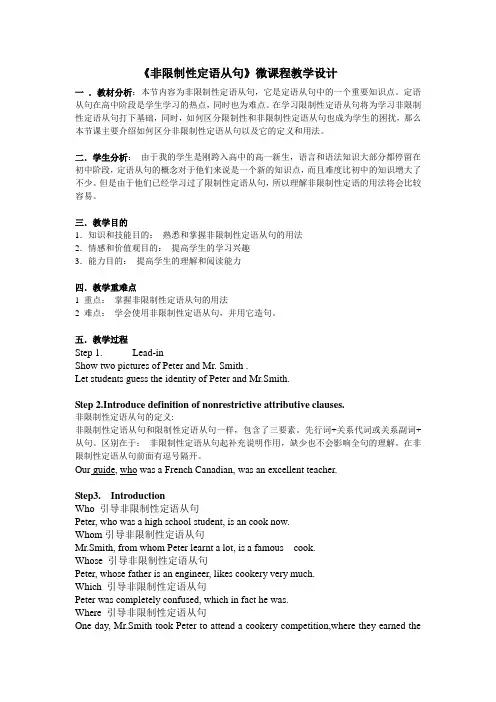
《非限制性定语从句》微课程教学设计一.教材分析:本节内容为非限制性定语从句,它是定语从句中的一个重要知识点。
定语从句在高中阶段是学生学习的热点,同时也为难点。
在学习限制性定语从句将为学习非限制性定语从句打下基础,同时,如何区分限制性和非限制性定语从句也成为学生的困扰,那么本节课主要介绍如何区分非限制性定语从句以及它的定义和用法。
二.学生分析:由于我的学生是刚跨入高中的高一新生,语言和语法知识大部分都停留在初中阶段,定语从句的概念对于他们来说是一个新的知识点,而且难度比初中的知识增大了不少。
但是由于他们已经学习过了限制性定语从句,所以理解非限制性定语的用法将会比较容易。
三.教学目的1.知识和技能目的:熟悉和掌握非限制性定语从句的用法2.情感和价值观目的:提高学生的学习兴趣3.能力目的:提高学生的理解和阅读能力四.教学重难点1 重点:掌握非限制性定语从句的用法2 难点:学会使用非限制性定语从句,并用它造句。
五.教学过程Step 1. Lead-inShow two pictures of Peter and Mr. Smith .Let students guess the identity of Peter and Mr.Smith.Step 2.Introduce definition of nonrestrictive attributive clauses.非限制性定语从句的定义:非限制性定语从句和限制性定语从句一样,包含了三要素。
先行词+关系代词或关系副词+从句。
区别在于:非限制性定语从句起补充说明作用,缺少也不会影响全句的理解。
在非限制性定语从句前面有逗号隔开。
Our guide, who was a French Canadian, was an excellent teacher.Step3. IntroductionWho 引导非限制性定语从句Peter, who was a high school student, is an cook now.Whom引导非限制性定语从句Mr.Smith, from whom Peter learnt a lot, is a famous cook.Whose 引导非限制性定语从句Peter, whose father is an engineer, likes cookery very much.Which 引导非限制性定语从句Peter was completely confused, which in fact he was.Where 引导非限制性定语从句One day, Mr.Smith took Peter to attend a cookery competition,where they earned thefirst price.When 引导非限制性定语从句Peter’father finally understood Peter’s dream, when he saw Peter in TV.as 引导非限制性定语从句As we all know, this story has a happy ending.常用as 的固定搭配:as we all know , as is known to allas is said above, as is often the caseas is reported in the newspaperStep4: Conclusionas 引导非限制性定语从句和which 的区别:1 .as 引导非限制性定语从句代替整个主句,而which 可以代替名词也可以代替主句。
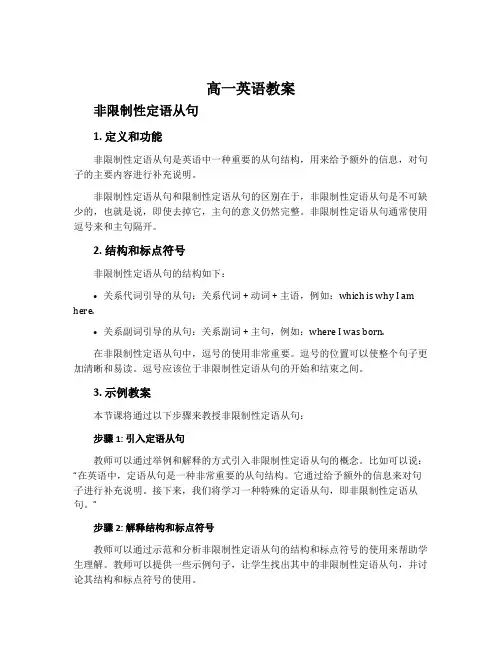
高一英语教案非限制性定语从句1. 定义和功能非限制性定语从句是英语中一种重要的从句结构,用来给予额外的信息,对句子的主要内容进行补充说明。
非限制性定语从句和限制性定语从句的区别在于,非限制性定语从句是不可缺少的,也就是说,即使去掉它,主句的意义仍然完整。
非限制性定语从句通常使用逗号来和主句隔开。
2. 结构和标点符号非限制性定语从句的结构如下:•关系代词引导的从句:关系代词 + 动词 + 主语,例如:which is why I am here.•关系副词引导的从句:关系副词 + 主句,例如:where I was born.在非限制性定语从句中,逗号的使用非常重要。
逗号的位置可以使整个句子更加清晰和易读。
逗号应该位于非限制性定语从句的开始和结束之间。
3. 示例教案本节课将通过以下步骤来教授非限制性定语从句:步骤1: 引入定语从句教师可以通过举例和解释的方式引入非限制性定语从句的概念。
比如可以说:“在英语中,定语从句是一种非常重要的从句结构。
它通过给予额外的信息来对句子进行补充说明。
接下来,我们将学习一种特殊的定语从句,即非限制性定语从句。
”步骤2: 解释结构和标点符号教师可以通过示范和分析非限制性定语从句的结构和标点符号的使用来帮助学生理解。
教师可以提供一些示例句子,让学生找出其中的非限制性定语从句,并讨论其结构和标点符号的使用。
步骤3: 练习和巩固教师可以设计一些练习来帮助学生巩固所学的知识。
例如,教师可以给学生一些句子,让他们根据上下文判断其中是否有非限制性定语从句,并标出其结构和标点符号的位置。
步骤4: 拓展练习教师可以设计一些拓展练习来挑战学生。
例如,教师可以给学生一篇短文,让他们找出其中的非限制性定语从句,并解释其结构和标点符号的使用。
4. 总结与评价通过本节课的学习,学生应该能够理解非限制性定语从句的定义、结构和标点符号的使用。
他们应该能够在阅读和写作中识别和运用非限制性定语从句,从而提高他们的英语表达能力。
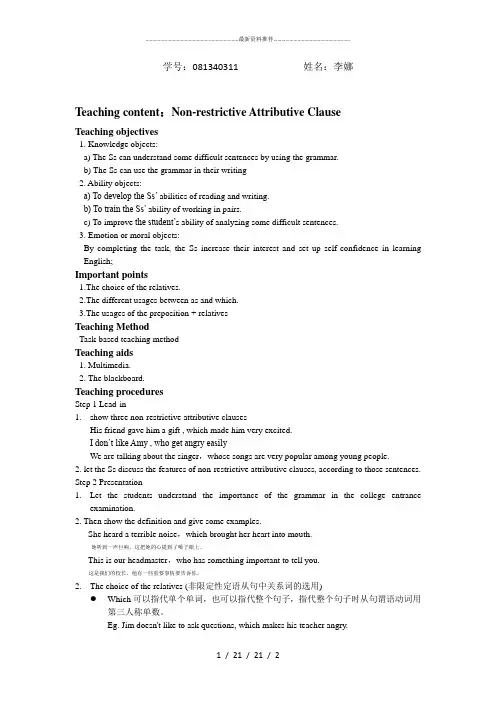
学号:081340311 姓名:李娜Teaching content:Non-restrictive Attributive ClauseTeaching objectives1. Knowledge objects:a) The Ss can understand some difficult sentences by using the grammar.b) The Ss can use the grammar in their writing2. Ability objects:a) To develop the Ss’ abilities of reading and writing.b) To train the Ss’ ability of working in pairs.c) To improve the student’s ability of analyzing some difficult sentences.3. Emotion or moral objects:By completing the task, the Ss increase their interest and set up self-confidence in learning English;Important points1.The choice of the relatives.2.The different usages between as and which.3.The usages of the preposition + relativesTeaching MethodTask-based teaching methodTeaching aids1. Multimedia.2. The blackboard.Teaching proceduresStep 1 Lead-in1.show three non-restrictive attributive clausesHis friend gave him a gift , which made him very excited.I don’t like Amy , who get angry easilyWe are talking about the singer,whose songs are very popular among young people.2. let the Ss discuss the features of non-restrictive attributive clauses, according to those sentences. Step 2 Presentation1.Let the students understand the importance of the grammar in the college entranceexamination.2. Then show the definition and give some examples.She heard a terrible noise,which brought her heart into mouth.她听到一声巨响,这把她的心提到了嗓子眼上。
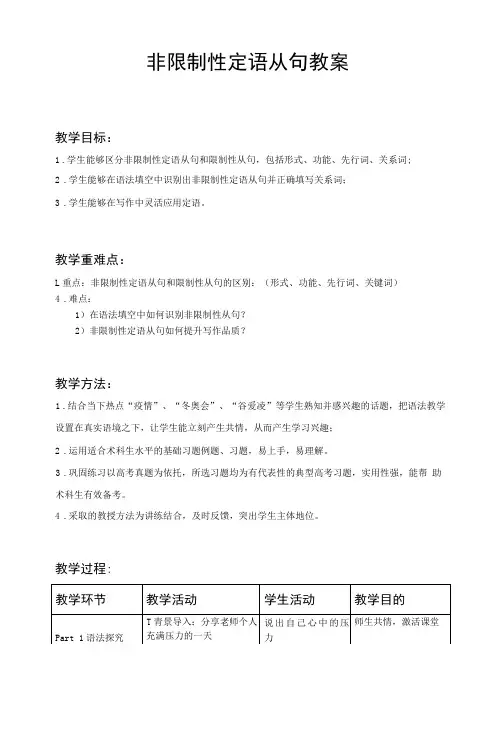
非限制性定语从句教案
教学目标:
1.学生能够区分非限制性定语从句和限制性从句,包括形式、功能、先行词、关系词;
2.学生能够在语法填空中识别出非限制性定语从句并正确填写关系词;
3.学生能够在写作中灵活应用定语。
教学重难点:
L重点:非限制性定语从句和限制性从句的区别:(形式、功能、先行词、关键词)
4.难点:
1)在语法填空中如何识别非限制性从句?
2)非限制性定语从句如何提升写作品质?
教学方法:
1.结合当下热点“疫情”、“冬奥会”、“谷爱凌”等学生熟知并感兴趣的话题,把语法教学设置在真实语境之下,让学生能立刻产生共情,从而产生学习兴趣;
2.运用适合术科生水平的基础习题例题、习题,易上手,易理解。
3.巩固练习以高考真题为依托,所选习题均为有代表性的典型高考习题,实用性强,能帮助术科生有效备考。
4.采取的教授方法为讲练结合,及时反馈,突出学生主体地位。
教学过程:。
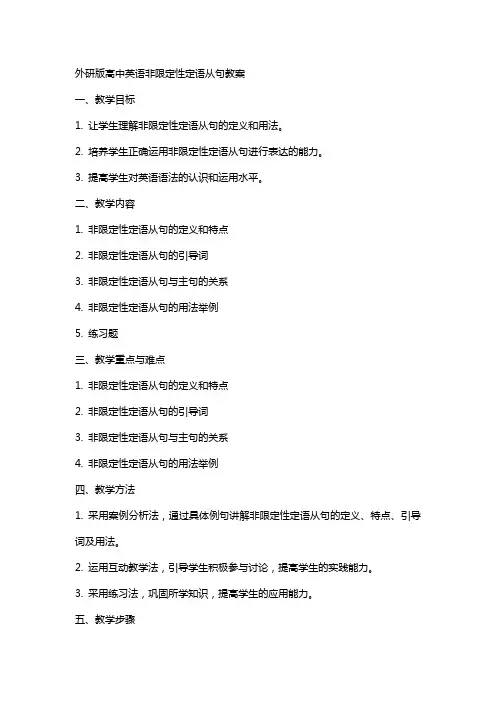
外研版高中英语非限定性定语从句教案一、教学目标1. 让学生理解非限定性定语从句的定义和用法。
2. 培养学生正确运用非限定性定语从句进行表达的能力。
3. 提高学生对英语语法的认识和运用水平。
二、教学内容1. 非限定性定语从句的定义和特点2. 非限定性定语从句的引导词3. 非限定性定语从句与主句的关系4. 非限定性定语从句的用法举例5. 练习题三、教学重点与难点1. 非限定性定语从句的定义和特点2. 非限定性定语从句的引导词3. 非限定性定语从句与主句的关系4. 非限定性定语从句的用法举例四、教学方法1. 采用案例分析法,通过具体例句讲解非限定性定语从句的定义、特点、引导词及用法。
2. 运用互动教学法,引导学生积极参与讨论,提高学生的实践能力。
3. 采用练习法,巩固所学知识,提高学生的应用能力。
五、教学步骤1. 引入非限定性定语从句的概念,让学生初步了解其定义和特点。
2. 讲解非限定性定语从句的引导词,如which、who、whom等,并举例说明。
3. 通过例句分析,让学生理解非限定性定语从句与主句的关系。
4. 结合实际语境,让学生学会正确运用非限定性定语从句进行表达。
5. 布置练习题,巩固所学知识,提高学生的应用能力。
六、教学拓展1. 引导学生了解非限定性定语从句在阅读理解中的作用,提高学生的阅读能力。
2. 分析非限定性定语从句在写作中的运用,帮助学生丰富句型结构,提高写作水平。
3. 通过实例,让学生了解非限定性定语从句在口语交流中的重要性,提高口语表达能力。
七、课堂练习1. 完成下列句子,使用非限定性定语从句:a. My friend ___ is ing to visit me next week.b. The book ___ you gave me is very interesting.c. The woman ___ is talking to my sister is her teacher.2. 判断下列句子中非限定性定语从句的使用是否正确:a. The man who is playing football is my brother.b. The cat, which is sleeping on the sofa, is very cute.c. The school, whose principal is Mr. Wang, is famous in our city.八、课后作业1. 复习本节课所学的非限定性定语从句的知识点。
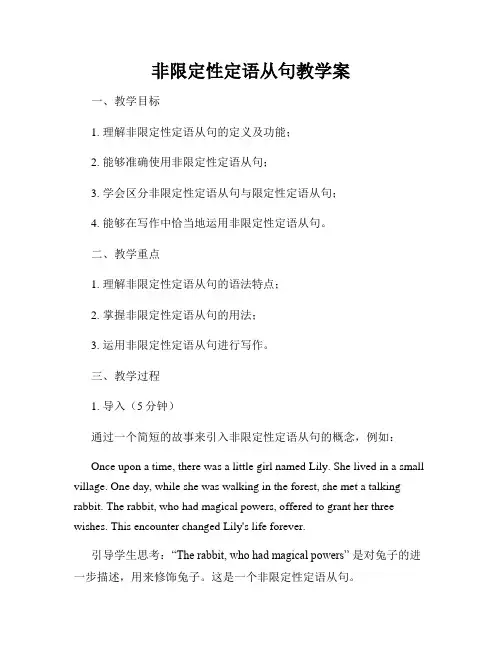
非限定性定语从句教学案一、教学目标1. 理解非限定性定语从句的定义及功能;2. 能够准确使用非限定性定语从句;3. 学会区分非限定性定语从句与限定性定语从句;4. 能够在写作中恰当地运用非限定性定语从句。
二、教学重点1. 理解非限定性定语从句的语法特点;2. 掌握非限定性定语从句的用法;3. 运用非限定性定语从句进行写作。
三、教学过程1. 导入(5分钟)通过一个简短的故事来引入非限定性定语从句的概念,例如:Once upon a time, there was a little girl named Lily. She lived in a small village. One day, while she was walking in the forest, she met a talking rabbit. The rabbit, who had magical powers, offered to grant her three wishes. This encounter changed Lily's life forever.引导学生思考:“The rabbit, who had magical powers” 是对兔子的进一步描述,用来修饰兔子。
这是一个非限定性定语从句。
2. 学习非限定性定语从句的定义和功能(10分钟)解释非限定性定语从句是用来修饰某一名词或代词的从句,但它不是这个名词或代词在句子中的主语或宾语。
非限定性定语从句通常用逗号或引号隔开,可以提供额外信息,增加句子的修饰效果。
举例说明:- My uncle, who lives in London, came to visit us last week. (非限定性定语从句修饰"uncle")- The book, written by a famous author, is very popular among teenagers. (非限定性定语从句修饰"book")解释非限定性定语从句的功能是为了进一步描述或补充名词或代词的信息,使句子更加丰富有趣。
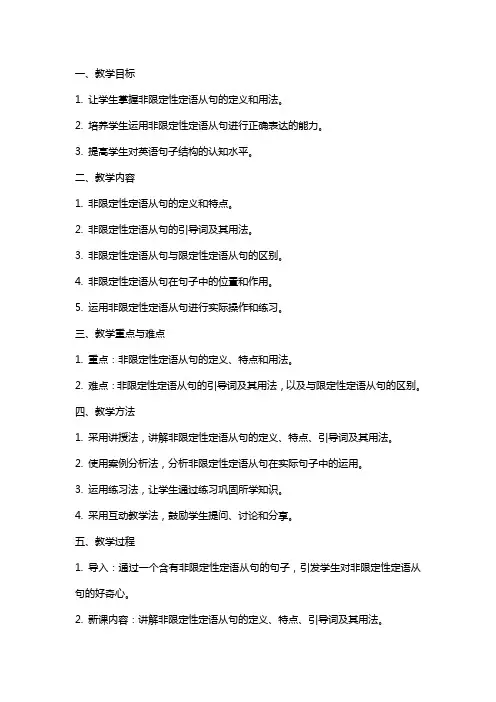
一、教学目标1. 让学生掌握非限定性定语从句的定义和用法。
2. 培养学生运用非限定性定语从句进行正确表达的能力。
3. 提高学生对英语句子结构的认知水平。
二、教学内容1. 非限定性定语从句的定义和特点。
2. 非限定性定语从句的引导词及其用法。
3. 非限定性定语从句与限定性定语从句的区别。
4. 非限定性定语从句在句子中的位置和作用。
5. 运用非限定性定语从句进行实际操作和练习。
三、教学重点与难点1. 重点:非限定性定语从句的定义、特点和用法。
2. 难点:非限定性定语从句的引导词及其用法,以及与限定性定语从句的区别。
四、教学方法1. 采用讲授法,讲解非限定性定语从句的定义、特点、引导词及其用法。
2. 使用案例分析法,分析非限定性定语从句在实际句子中的运用。
3. 运用练习法,让学生通过练习巩固所学知识。
4. 采用互动教学法,鼓励学生提问、讨论和分享。
五、教学过程1. 导入:通过一个含有非限定性定语从句的句子,引发学生对非限定性定语从句的好奇心。
2. 新课内容:讲解非限定性定语从句的定义、特点、引导词及其用法。
3. 案例分析:分析非限定性定语从句在实际句子中的运用,帮助学生理解并区分非限定性定语从句和限定性定语从句。
4. 课堂练习:设计一些练习题,让学生运用所学知识进行实际操作。
5. 互动环节:鼓励学生提问、讨论和分享,解答学生在学习过程中遇到的问题。
六、教学策略1. 运用多媒体教学手段,如PPT、视频等,增强课堂的趣味性。
2. 通过例句和练习,让学生在实际语境中感受和理解非限定性定语从句的用法。
3. 创设真实语境,让学生在交流互动中运用非限定性定语从句。
4. 针对学生的不同水平,设计多层次、多类型的练习,满足学生的学习需求。
5. 注重个体差异,给予学生个性化的指导和关爱,帮助每个学生提高。
七、教学评价1. 课堂参与度:观察学生在课堂上的发言、提问和互动情况,了解学生的学习积极性。
2. 练习完成情况:检查学生课堂练习和课后作业的完成质量,评估学生的学习效果。
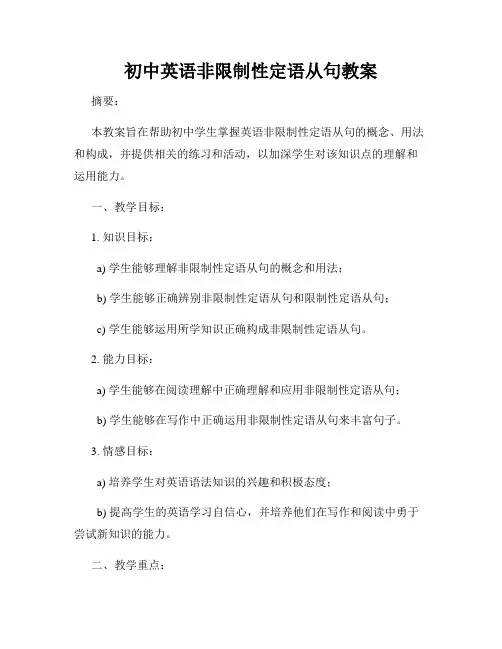
初中英语非限制性定语从句教案摘要:本教案旨在帮助初中学生掌握英语非限制性定语从句的概念、用法和构成,并提供相关的练习和活动,以加深学生对该知识点的理解和运用能力。
一、教学目标:1. 知识目标:a) 学生能够理解非限制性定语从句的概念和用法;b) 学生能够正确辨别非限制性定语从句和限制性定语从句;c) 学生能够运用所学知识正确构成非限制性定语从句。
2. 能力目标:a) 学生能够在阅读理解中正确理解和应用非限制性定语从句;b) 学生能够在写作中正确运用非限制性定语从句来丰富句子。
3. 情感目标:a) 培养学生对英语语法知识的兴趣和积极态度;b) 提高学生的英语学习自信心,并培养他们在写作和阅读中勇于尝试新知识的能力。
二、教学重点:1. 理解非限制性定语从句的概念和用法;2. 能够正确辨别和构成非限制性定语从句。
三、教学内容及安排:1. 导入(5分钟)a) 通过教师提问和学生回答的方式,复习限制性定语从句的概念和用法。
2. 概念讲解(10分钟)a) 教师给出非限制性定语从句的定义,并与限制性定语从句进行对比说明;b) 教师给出非限制性定语从句的句子结构和标点要求,并解释其具体用法。
3. 语法讲解(10分钟)a) 教师通过例句和语法规则的讲解,深入解析非限制性定语从句的构成和使用方法;b) 教师重点讲解非限制性定语从句与主句之间的关系,以及修饰对象的不同形式。
4. 练习与活动(20分钟)a) 学生进行非限制性定语从句的判断练习,区分限制性定语从句和非限制性定语从句;b) 学生通过阅读材料,找出其中的非限制性定语从句,并分析其作用;c) 学生进行小组活动,编写句子并运用非限制性定语从句,以实际运用巩固所学知识。
5. 拓展练习(10分钟)a) 学生配对练习,互相出题并回答关于非限制性定语从句的问题;b) 学生进行语法填空练习,使用非限制性定语从句来完善句子。
6. 总结与反思(5分钟)a) 教师帮助学生总结非限制性定语从句的特点和用法;b) 学生针对所学内容,进行自我反思并提出疑问。

非限制性定语从句非限制性定语从句语境呈现1观察下列句子,注意划线部分的用法。
1)This note was left by Mr.Li,who was here a moment ago.2)This novel,which I have read three times,is very touching.3)The bus ran into a crowd of people,some of whom were sent to hospital.4China has hundreds of islands,the largest of which is Taiwan.5)She was kinder to her youngest son than to the others,which,of course,made the others envy him.6)All of my books are on the desk,where I always keep them.7)My brother,whose skin is a little black,has a slim figure.8)They decided to put off the meeting until next Saturday,when they wouldn’t be so busy.规律精点1 所谓非限制性定语从句,顾名思义,对主句所描述的人或物起的作用,去掉后主句意思仍然完整;它与句子之间常用逗号隔开,其引导词有who,whom,whose,which,when,where,as。
that和why 不能引导分限制性定语从句。
有时用不定代词、数词或形容词最高级+of+whom/which指代先行词或先行词的一部分。
语境呈现2观察下列句子,注意划线部分的用法。
1)As is known to us,the sky is blue.The sky is blue,which is known to us.2)The big tree was cut down yesterday,as is reported in today’s newspaper.The big tree was cut down yesterday,which is about three hundred years old.规律精点2 关系代词as引导非限制性定语从句,其与which的区别在于:1)as引导的非限制性定语从句可置于句首、居中或句尾;which引导的非限制性定语从句只能置于。
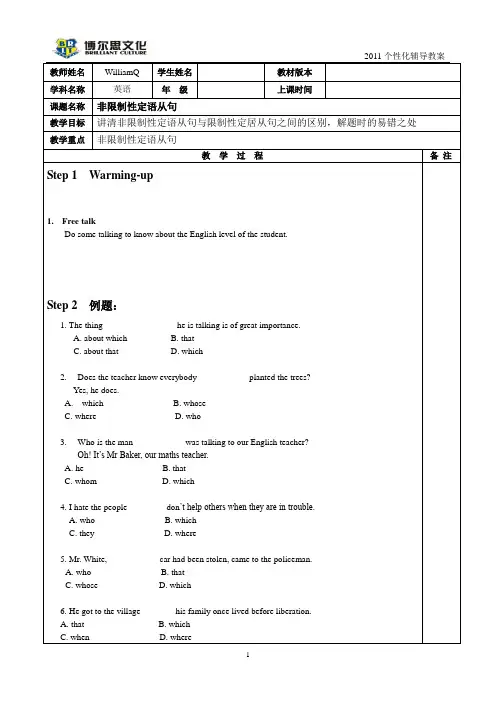
教师姓名WilliamQ 学生姓名教材版本学科名称英语年级上课时间课题名称非限制性定语从句教学目标讲清非限制性定语从句与限制性定居从句之间的区别,解题时的易错之处教学重点非限制性定语从句教学过程备注Step 1 Warming-up1.Free talkDo some talking to know about the English level of the student.Step 2 例题:1. The thing ________________ he is talking is of great importance.A. about whichB. thatC. about thatD. which2. ---Does the teacher know everybody ___________ planted the trees?---Y es, he does.A. whichB. whoseC. whereD. who3. ---Who is the man ___________ was talking to our English teacher?---Oh! It’s Mr Baker, our maths teacher.A. heB. thatC. whomD. which4. I hate the people ________ don’t help others when they are in trouble.A. whoB. whichC. theyD. where5. Mr. White, ___________ car had been stolen, came to the policeman.A. whoB. thatC. whoseD. which6. He got to the village _______ his family once lived before liberation.A. thatB. whichC. whenD. where7. This is the house _______ I want to buy.A. in whichB. thatC. whoseD. where8. This is the house _______ our beloved Premier Zhou once lived and worked.A. whichB. thatC. whenD. where9. He didn’t tell me the place _______ he was born.A. thatB. whichC. whenD. where10. He lived in a small village, ______ was a long way from the railway station.A. thatB. whichC. whereD. when11.______ is well known to everybody, Taiwan is an inseparable part of China.A. AsB. WhichC. ThatD. WhereStep 3 知识点:一】非限制性定语从句:1)①非限定性定语从句起补充说明作用,缺少也不会影响全句的理解。
一、教学目标1. 让学生掌握非限定性定语从句的定义和基本用法。
2. 培养学生正确运用非限定性定语从句表达思想的能力。
3. 提高学生对英语语法的认识和运用能力。
二、教学内容1. 非限定性定语从句的定义和特点。
2. 非限定性定语从句的引导词及其用法。
3. 非限定性定语从句与限定性定语从句的区别。
4. 非限定性定语从句在句子中的位置和作用。
5. 非限定性定语从句的翻译方法和技巧。
三、教学重点与难点1. 重点:非限定性定语从句的定义、引导词及其用法。
2. 难点:非限定性定语从句在句子中的位置和作用,以及与限定性定语从句的区别。
四、教学方法1. 采用案例分析法,通过大量例句让学生直观地理解非限定性定语从句的用法。
2. 运用对比分析法,让学生明确非限定性定语从句与限定性定语从句的区别。
3. 采用任务型教学法,让学生在实践中运用非限定性定语从句进行语言表达。
五、教学过程1. 导入:通过一个谜语引出非限定性定语从句的概念。
2. 讲解:讲解非限定性定语从句的定义、特点、引导词及其用法。
3. 示例:分析一些含有非限定性定语从句的例句,让学生理解其在句子中的作用。
4. 练习:让学生分组练习,用非限定性定语从句改写一些句子。
5. 总结:概括本节课的主要内容,强调非限定性定语从句的用法和位置。
6. 作业:布置一些有关非限定性定语从句的练习题,让学生巩固所学知识。
六、教学拓展1. 引导学生了解非限定性定语从句在英语写作中的作用,如增强句子表达能力、使句子更灵活等。
2. 介绍一些常见的非限定性定语从句的错误类型,并引导学生学会避免这些错误。
七、课堂互动1. 采用小组讨论的方式,让学生共同探讨非限定性定语从句的用法。
2. 设计一些填空题、改错题等,让学生在互动中巩固所学知识。
八、教学评价1. 课后收集学生的作业,检查他们对非限定性定语从句的掌握情况。
2. 在下一节课开始时,进行一个小测验,测试学生对非限定性定语从句的掌握程度。
非限制性定语从句一、定语从句的概念在复合句中,修饰某一名词或代词的从句叫定语从句。
被修饰的名词或代词叫先行词,定语从句一般放在先行词的后面。
二、定语从句的关系词引导定语从句的关系词有关系代词和关系副词,常见的关系代词包括that,which,who(宾格whom,所有格whose)等,关系副词包括where,when,why等。
关系代词和关系副词放在先行词及定语从句之间起连接作用,同时又作定语从句的重要成分。
三、定语从句的分类根据定语从句与先行词的关系,定语从句可分为限制性定语从句及非限制性定语从句。
限制性定语从句紧跟先行词,主句与从句不用逗号分开,从句不可省去,非限制性定语从句主句与从句之间有逗号分开,起补充说明作用,如省去,意思仍完整。
四、关系代词的用法1. that 既可以用于指人,也可以用于指物。
在从句中作主语或宾语,作主语时不可省略,作宾语可省略。
例如:Mary likes music that is quiet and gentle.玛丽喜欢轻柔的音乐。
(that作主语)The coat (that)I put on the desk is blue.我放在桌子上的那件外套是蓝色的。
(that作宾语)2.which用于指物,在句中作主语或宾语,作主语不可省略,作宾语可省略。
例如:The building which stands near the train station is a supermarket.位于火车站附近的那座大楼是一家超市。
(作主语)The film (which)we saw last night was wonderful. 我们昨天晚上看的那部电影很好看。
(作宾语)3.who,whom用于指人,who 用作主语,whom用作宾语。
在口语中,有时可用who代替whom,也可省略。
例如:The girl who often helps me with my English is from England.经常在英语方面帮助我的那个女孩是英国人。
非限制性定语从句学案一、课前准备1.定语从句有两种基本形式:_______________和_______________;1).什么是限制性定语从句?限制性定语从句,是对先行词从本质或特征上进行限制的一种定语从句,它所修饰的词代表一个(些)或一类特定的人或事、物。
2).什么是非限制性定语从句?非限制性定语从句,它只对所修饰的词作进一步的说明,去掉之后并不影响句子的整个含义。
在形式上,非限制性定语从句与主句之间通常用逗号隔开。
2.辨别下列句子,哪句是限制性定语从句,哪句是非限制性定语从句?1).Finally we visited to the Giant Yangtze Gorges Dam, which is the greatest key water control pro ject in the world at present.2).A man who doesn't learn from others can't achieve much.3. 从本单元<KEEP IT UP, XIE LEI>文章中找出含非限制性定语从句的句子。
二、课堂互动1.思考下列问题。
1)Heat is another form of energy, which is as important as other kinds of energy.(which可以用that替换吗?)2)That Peter will marry Alice, which has not been announced yet, has spread around.(这句的which指的是什么?)(用合适的引导词填空,完成句子3,4,5,6,7,8)3)Miss Howe, _______ you met in the library, is our new teacher.4) The Arabs, ______ are famous for their horses and camels, use these animals for work and insports.5) Li Ming, ________ mother has been ill for two days, is absent from school today.6) He lives in the city, _______ there is a high tower.7) The People’s Republic of China was founded in 1949, _______ he was born.8) Wu Dong, ______________I went to see the film, enjoyed it very much.9) He was eager to go to the hospital to see his stepmother, whom he loved and respected as hisown mother. (此句中的whom可以省略吗?)10) Have you got the postcard which I sent you? (此句中的which可以省略吗?)(用合适的引导词填空,完成句子11,12,13)11) He wrote a book, the name of ________ I’ve completely forgotten.12) It’s a family of eight people, all of _______ love music.13) There are fifty students in the class, sixty percent of _______are boys.小结: 1) that 不会用于____________;2) which除了可以指代前面的先行词,还可以指代___________.3) 用于非限制性定语从句中的引导词有哪些?4)在限制性定语从句中作宾语时,引导词可以________,但引导非限制性定语从句的关联词________。
非限制性定语从句教案【篇一:非限制性定语从句优秀教案】non-restrictive attributive clausesstep1 reviewfinish the attributive clauses below:1. the lesson __________ we studied yesterday was interesting.2.do you know the girl____ is a dancer.3. don’t4. the girl ______you saw at the meeting is a well-known swimmer.5. he has a sister ______ name i can’t remember.6. i never really understand the reason ____ he made such a serious mistake.7. i still remember the days _____ we studied together.8. people like to live in a place _____ there’s fresh air and little noise.总结:关系代词:;关系副词: .step2 while-grammarexample1:compare the two sentences in the same group and find out the differences between them.1).the old man has a son ,who is in the army.2).the old man has a son who is in the army.1)中的从句是翻译:.(隐含的意思:).2)中的从句是翻译:.(隐含的意思:).practice: (translation)in the class, there are 36 students who are interested in pop music.in the class, there are 36 students,who are interested in pop music.conclusion 11.限制性定语从句与先行词关系缺少)的部分, 去掉它,主句意思(a:不明确;b: 明确.)翻译时,从句先译,“…的”2.非限制性定语从句是对先行词的补充说明,去掉翻译时,主句先译,从句单独成句.总结:注意:和不能引导非限制性定语从句。
非限定性定语从句教案章节一:非限定性定语从句的概念与作用1. 引入:引导学生回顾已学过的定语从句知识,提问学生对限定性定语从句的理解。
2. 讲解:非限定性定语从句的定义、作用和与主句的关系。
举例说明非限定性定语从句对主句的补充说明作用。
3. 练习:让学生练习判断句子中的定语从句是限定性还是非限定性,并解释原因。
章节二:非限定性定语从句的引导词1. 引入:提问学生已学过的定语从句引导词,如“who”、“whom”、“which”等。
2. 讲解:介绍非限定性定语从句的常见引导词,如“which”、“who”、“whom”、“that”等。
强调这些引导词在非限定性定语从句中的用法和作用。
3. 练习:让学生练习使用非限定性定语从句的引导词,完成练习句子。
章节三:非限定性定语从句的位置1. 引入:提问学生定语从句在句子中的位置。
2. 讲解:讲解非限定性定语从句可以放在主句之前或之后,以及逗号的使用规则。
强调非限定性定语从句对主句的补充说明作用。
3. 练习:让学生练习判断非限定性定语从句在句子中的正确位置,并改正错误的位置。
章节四:非限定性定语从句与主句的关系1. 引入:提问学生定语从句与主句的关系。
2. 讲解:讲解非限定性定语从句与主句的逻辑关系,如因果关系、转折关系等。
举例说明非限定性定语从句在句子中的作用。
3. 练习:让学生练习分析句子中非限定性定语从句与主句的关系,并解释原因。
章节五:非限定性定语从句的翻译技巧1. 引入:提问学生定语从句的翻译技巧。
2. 讲解:讲解非限定性定语从句的翻译技巧,如按照中文习惯进行断句、调整语序等。
举例说明非限定性定语从句在翻译中的处理方法。
3. 练习:让学生练习翻译含有非限定性定语从句的句子,注意运用翻译技巧。
章节六:非限定性定语从句在复杂句子中的应用1. 引入:提问学生在复杂句子中遇到定语从句时的处理方法。
2. 讲解:讲解非限定性定语从句在复杂句子中的应用,如修饰名词短语、代词、副词等。
非限制性定语从句教案【篇一:非限制性定语从句优秀教案】non-restrictive attributive clausesstep1 reviewfinish the attributive clauses below:1. the lesson __________ we studied yesterday was interesting.2.do you know the girl____ is a dancer.3. don’t4. the girl ______you saw at the meeting is a well-known swimmer.5. he has a sister ______ name i can’t remember.6. i never really understand the reason ____ he made such a serious mistake.7. i still remember the days _____ we studied together.8. people like to live in a place _____ there’s fresh air and little noise.总结:关系代词:;关系副词: .step2 while-grammarexample1:compare the two sentences in the same group and find out the differences between them.1).the old man has a son ,who is in the army.2).the old man has a son who is in the army.1)中的从句是翻译:.(隐含的意思:).2)中的从句是翻译:.(隐含的意思:).practice: (translation)in the class, there are 36 students who are interested in pop music.in the class, there are 36 students,who are interested in pop music.conclusion 11.限制性定语从句与先行词关系缺少)的部分, 去掉它,主句意思(a:不明确;b: 明确.)翻译时,从句先译,“…的”2.非限制性定语从句是对先行词的补充说明,去掉翻译时,主句先译,从句单独成句.总结:注意:和不能引导非限制性定语从句。
学号:081340311 姓名:李娜
Teaching content:Non-restrictive Attributive Clause
Teaching objectives
1. Knowledge objects:
a) The Ss can understand some difficult sentences by using the grammar.
b) The Ss can use the grammar in their writing
2. Ability objects:
a) To develop the Ss’ abilities of reading and writing.
b) To train the Ss’ ability of working in pairs.
c) To improve the student’s ability of analyzing some difficult sentences.
3. Emotion or moral objects:
By completing the task, the Ss increase their interest and set up self-confidence in learning English;
Important points
1.The choice of the relatives.
2.The different usages between as and which.
3.The usages of the preposition + relatives
Teaching Method
Task-based teaching method
Teaching aids
1. Multimedia.
2. The blackboard.
Teaching procedures
Step 1 Lead-in
1.show three non-restrictive attributive clauses
His friend gave him a gift , which made him very excited.
I don’t like Amy , who get angry easily
We are talking about the singer,whose songs are very popular among young people.
2. let the Ss discuss the features of non-restrictive attributive clauses, according to those sentences. Step 2 Presentation
1.Let the students understand the importance of the grammar in the college entrance
examination.
2. Then show the definition and give some examples.
She heard a terrible noise,which brought her heart into mouth.
她听到一声巨响,这把她的心提到了嗓子眼上。
This is our headmaster,who has something important to tell you.
这是我们的校长,他有一些重要事情要告诉你。
2.The choice of the relatives (非限定性定语从句中关系词的选用)
Which可以指代单个单词,也可以指代整个句子,指代整个句子时从句谓语动词用第三人称单数。
Eg. Jim doesn't like to ask questions, which makes his teacher angry.
He is looking for the key, which belongs to my sister.
●As 引导定语从句意为“ 正如”。
也可指代整个句子。
常用句型有:as we all know,
as is known to all,as is expected等
He did the experiment successfully,as had been expected.
As we all know,paper was first made in China.
●Who whom who在非限定性定语从句中做做主语, Whom在非限定性定语从句中做
宾语,不能用who替代
Here is Mr . White , whom you want to talk to .
I have a sister,who is a doctor.
●Whose在非限定性定语从句中做定语,意为“…的”可指代人或者物
Li Ming, whose mother has been ill for two days, is absent from school today.
●介词+关系代词(只用which和whom且不能省略)
Frederick Willian I, to whom the amber room belonged ,decided not to keep it.
Can you lend me the book,about which you talked the other day?
●关系副词where和when在非限制性定语从句中作状语。
He was quickly taken to hospital,where a doctor would examine Mr King's legs
Einstein left Germany for the United States during World War II, when Jews were badly t
reated in Germany.
Step 3 Conclusion and consolidation
1.Summarize the important points.
2.Do some exercise .
Step 4 Homework
Finish page 3 after class.
Blackboard design
Non-restrictive Attributive Clause
关系词:关系代词which
as
who whom
whose
介词+关系代词
关系副词where when。